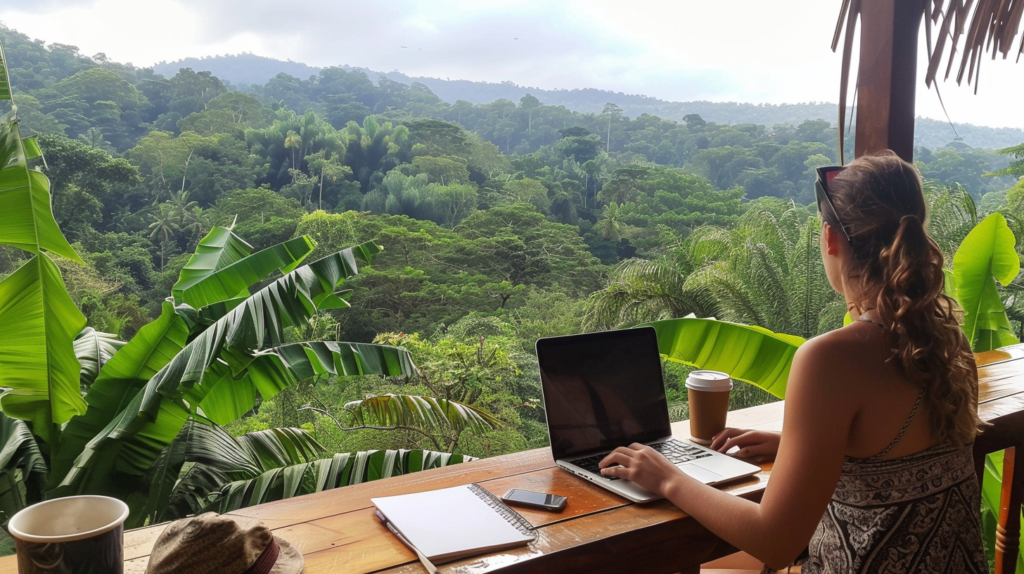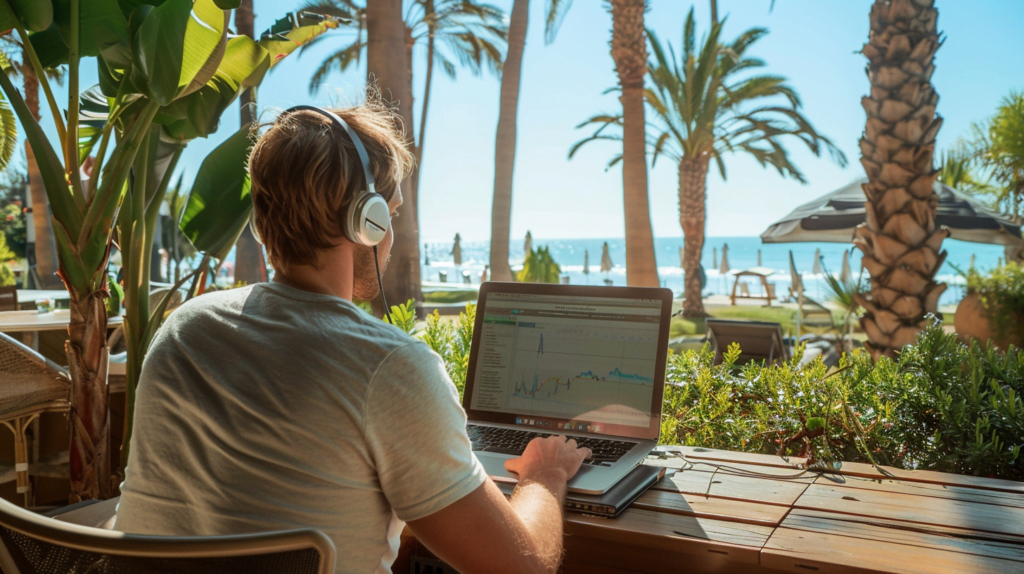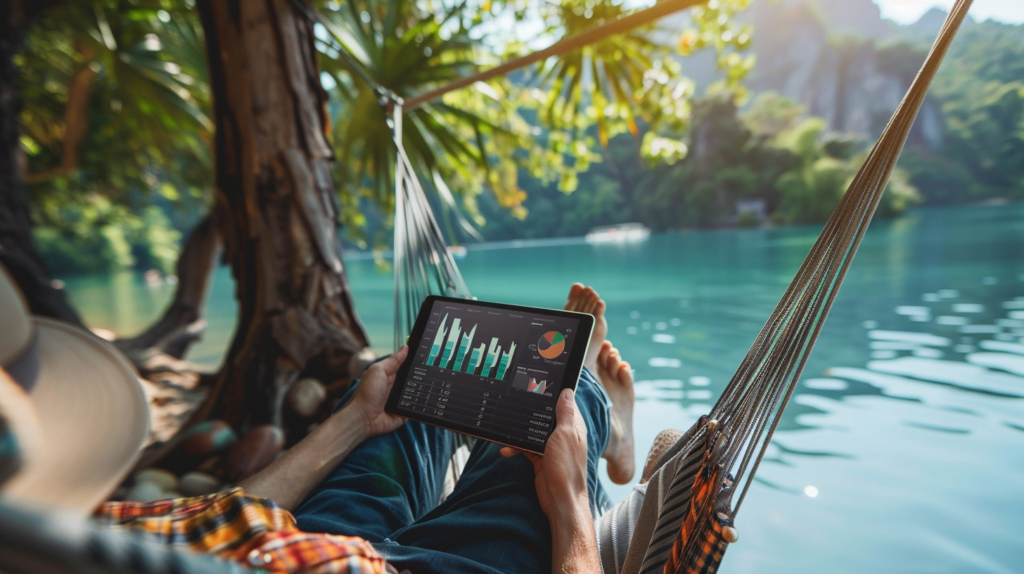
Welcome to EcoNomadic Wanderer, your go-to source for all things related to the digital nomad lifestyle and sustainable travel. In today’s blog post, we’re diving into one of the most frequently asked questions: “How digital nomads get paid?” As someone who has embraced the digital nomad lifestyle for the past three years, I’ve navigated various income streams and learned valuable lessons along the way. This complete guide aims to share those insights, helping you understand the myriad ways you can sustain your remote work lifestyle while traveling the world.
Introduction
When I first started my journey as a digital nomad, the concept of working remotely was still relatively new. I remember sitting in a quaint café in Bali, sipping on a freshly brewed cup of coffee, and feeling a mix of excitement and apprehension about my new lifestyle. My initial days were filled with uncertainty. I had just left a stable corporate job to pursue my dream of traveling while working, and I had to figure out how to make a living without the traditional 9-to-5 safety net.
My first foray into earning money on the road was through freelancing. I had always enjoyed writing, so I decided to offer content writing services. My first client was a small eco-friendly startup that needed blog posts and social media content. I still remember the thrill of receiving my first payment while sitting on a beach in Thailand. It wasn’t a lot, but it was enough to cover my expenses and gave me the confidence to keep going. Over time, I built a portfolio and expanded my client base, eventually specializing in sustainable travel writing. This specialization not only aligned with my personal values but also helped me carve out a niche in a competitive market.
As I continued my journey, I discovered remote employment opportunities. One of the most significant milestones in my digital nomad career was securing a remote marketing position with a sustainable fashion brand. This role provided a stable income and the flexibility to travel, all while contributing to a cause I’m passionate about. I remember working from a co-working space in Medellín, Colombia, surrounded by fellow digital nomads. The sense of community and shared experiences made the challenges of remote work more manageable and enjoyable.

In addition to freelancing and remote employment, I explored passive income streams to ensure a steady cash flow. One of my most successful ventures was creating an online course on sustainable travel. The course covered topics such as eco-friendly travel tips, sustainable accommodation options, and responsible tourism practices. This not only generated passive income but also allowed me to share my passion for sustainable travel with a broader audience. Additionally, I utilized affiliate marketing to recommend eco-friendly travel gear and services on my blog. By partnering with brands that aligned with my values, I was able to monetize my content without compromising my integrity.
Starting an online business was another avenue I explored. I launched an e-commerce store selling eco-friendly travel accessories. This venture not only provided income but also supported my commitment to sustainability. The store featured products like reusable water bottles, biodegradable toiletries, and non disposable high quality utensils. Managing the store while traveling posed its challenges, but it was incredibly rewarding to see orders come in from around the world.

Navigating these various income streams has taught me valuable lessons about flexibility, adaptability, and resilience. Each method has its unique benefits and challenges, and finding the right mix has been a journey of continuous learning and growth. My experiences have shown me that there is no one-size-fits-all approach to getting paid as a digital nomad. It’s about finding what works best for you and aligning your work with your lifestyle and values.
In this guide, I’ll delve into the details of these income streams, sharing tips and resources to help you succeed as a digital nomad. Whether you’re just starting or looking to diversify your income, this comprehensive guide will provide the insights you need to sustain your nomadic lifestyle while making a positive impact on the world.
How Digital Nomads Get Paid: Freelancing

Freelancing is a top choice for many digital nomads looking to get paid while enjoying the freedom to work from anywhere. It offers unmatched flexibility and the chance to tailor your work to your interests and skills. As a freelancer, you can provide services like writing, graphic design, web development, marketing, and consulting. Thanks to platforms like Upwork, Fiverr, and Freelancer.com, finding clients worldwide has never been easier.
Example: When I first started freelancing, I offered content writing services. My initial project was with a travel blog that needed engaging articles about various destinations. This project allowed me to research and write about fascinating places, enriching my own travel knowledge while providing valuable content for the blog. As I completed more projects, my portfolio grew, and I began attracting clients from different industries, including tech and lifestyle. Eventually, I found my niche in writing about sustainable travel, which not only aligned with my personal values but also helped me stand out in a competitive market. This specialization enabled me to build a loyal client base and enjoy a steady stream of interesting and meaningful work.
| Advantages | Disadvantages |
|---|---|
| Flexibility to choose projects and clients. | Income can be inconsistent, especially in the beginning. |
| Ability to work from anywhere with an internet connection. | Requires self-discipline and time management skills. |
| Opportunity to build a diverse portfolio and gain experience in various fields. | Finding and securing clients can be time-consuming. |
Tips for Success:
- Create a strong portfolio showcasing your skills.
- Set competitive rates and be willing to negotiate.
- Build long-term relationships with clients to ensure repeat business.
Resources:
How Digital Nomads Get Paid: Remote Employment

Remote employment is a fantastic option for digital nomads, offering the chance to work from anywhere while maintaining job stability. Many companies now provide remote work opportunities, whether full-time, part-time, or contract positions. Websites like Remote.co, We Work Remotely, and FlexJobs are great places to find these jobs.
Example: I landed a remote marketing role with a travel agency specializing in eco-friendly tours. This position gave me a steady income and the freedom to travel. My days were spent coordinating with my team via video calls and managing marketing campaigns from beautiful locations like a serene beach in Thailand or a bustling café in Paris. The freedom was exhilarating, and I learned invaluable skills in remote team management and digital marketing. This experience not only allowed me to work in a field I love but also enriched my personal and professional life.
| Advantages | Disadvantages |
|---|---|
| Stable income with benefits similar to traditional employment. | May have to adhere to specific work hours, which can limit travel flexibility. |
| Opportunity to work for reputable companies without being tied to a physical location. | Potential challenges in communication and collaboration with team members across different time zones. |
| Access to resources and support from an employer. | Less autonomy compared to freelancing. |
Tips for Success:
- Tailor your resume to highlight remote work skills.
- Utilize LinkedIn to network with potential employers.
- Be proactive in searching for job opportunities.
Resources:
How Digital Nomads Get Paid: Passive Income Streams

Passive income streams are crucial for digital nomads looking to maintain a steady flow of income without being tied to constant work. These streams can include investments, affiliate marketing, creating online courses, and selling digital products.
Example: I developed a consulting service for crafting travel itineraries with a focus on sustainable travel practices. By offering personalized advice and detailed plans that emphasize eco-friendly accommodations, local transportation options, and responsible tourism activities, I created a valuable resource for travelers. I promoted this service through my blog and social media channels, attracting clients who are passionate about sustainable travel. Additionally, I utilized affiliate marketing by recommending eco-friendly travel gear and services in my itineraries and blog posts. Partnering with brands that share my values, I earn commissions on sales generated through these recommendations. This approach not only ensures a steady income but also allows me to advocate for sustainable travel practices, aligning my work with my personal mission.
| Advantages | Disadvantages |
|---|---|
| Income is generated with minimal ongoing effort. | Initial setup can be time-consuming and requires upfront effort. |
| Can diversify income sources to reduce financial risk. | Income may be slow to start and grow over time. |
| Allows for more freedom and flexibility in your schedule | Requires ongoing promotion and marketing to maintain revenue. |
Tips for Success:
- Invest time in creating high-quality digital products.
- Choose affiliate programs that align with your niche.
- Continuously promote your products and services through your blog and social media.
Resources:
How Digital Nomads Get Paid: Online Businesses

Starting an online business is a fantastic way for digital nomads to create a steady income while exploring the world. This could be an e-commerce store, a dropshipping venture, or a subscription service. The secret to success is finding a niche you’re passionate about and that has market demand.
Example: I launched an e-commerce store selling eco-friendly travel accessories, featuring items like reusable water bottles, biodegradable toiletries, and high quality non-disposable travel essentials. Running the store while traveling had its challenges, such as managing suppliers and customer inquiries across different time zones. However, it was incredibly rewarding to see orders coming in from around the globe. Platforms like Shopify helped automate many aspects of the business, allowing me to focus on marketing and customer service, making the whole process much smoother and more enjoyable.
| Advantages | Disadvantages |
|---|---|
| Potential for high income and scalability. | Requires significant initial investment and ongoing management. |
| Ability to create a brand that aligns with your values and interests. | Competition can be fierce, depending on the niche. |
| Flexibility to run the business from anywhere. | Needs consistent effort in marketing and customer engagement. |
Tips for Success:
- Conduct thorough market research.
- Develop a strong brand identity.
- Utilize social media and SEO to drive traffic to your store.
Resources:
Conclusion

How Digital Nomads Get Paid can come from a variety of sources, each offering unique benefits and challenges. Whether you choose freelancing, remote employment, passive income streams, or starting an online business, the key is to find what works best for you and aligns with your lifestyle and values. Embrace the flexibility and freedom that comes with being a digital nomad, and always be open to new opportunities.
#If you found this guide helpful, please leave a comment below with your experiences or questions about how digital nomads get paid. I’d love to hear from you and continue the conversation!



